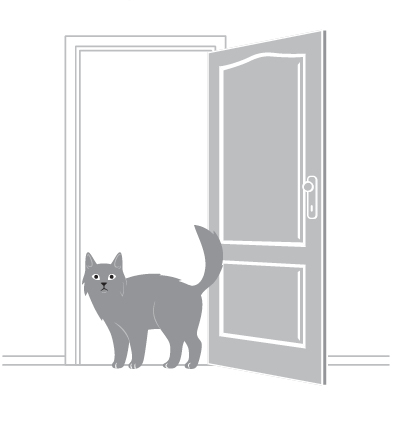16
When Your Cat Exhibits Annoying, Attention-Seeking Behaviors
HANDS DOWN, IF I have a job, it’s due to three things: litterbox issues, aggression, or the huge pile of aggravation contained in this chapter. However, these issues are the ones that routinely drive guardians to the brink faster than the other two. I guess irritating rings that bell faster than despairing. I know clients who have swept peeing problems under the rug (sometimes literally) for years. Waking you up in the middle of the night? That’s what gives you the impetus to track me down in the cereal aisle of the supermarket (and for those who have, yes, I still like Cap’n Crunch—don’t judge).
CAT DADDY RECIPE NO. 4—
THE ANNOY-ILATOR

The Problem:
From clawing up the curtains to climbing the walls, swinging from the chandeliers (both metaphorically and literally), scratching artwork, knocking things over, and being what some might call a “pain in the ass,” or what the Internet has dubbed “Asshole Cat,” your cat is driving you crazy with his annoying behavior. And worse yet, he seems to be fully aware that it’s driving you crazy.
The Reality:
If my last point hits home, let’s start by stepping away from the crazy. In many cases, unwanted nuisance behavior is something we bring on ourselves, because there’s something in it for the cat. If your cat meows incessantly, wakes you up in the middle of the night, sits in front of your computer monitor or in your lap while you read the newspaper, or scratches or bites you as a way of trying your patience, there’s always a payoff. When you’re annoyed by a behavior, you give it weight by showing your dissatisfaction in some way (usually by yelling), or by appeasing your cat by rewarding the behavior. Either way, to your cat, all attention is reward.
I’m going to give you suggestions that will address the “big picture”—which is why your cat is being annoying in the first place. Then I’ll talk about the most common nuisance behaviors and some specific remedies to restore your relationship with your “asshole cat.”
The Steps:
- Battle Boredom: This means we step up our play routine, making sure that it is routine, a ritual, and a part of our daily rhythm. Your cats need their energy drained in a constructive way each day. Remember our mantra: Play = Prey. Engage your cats in play during high-energy times of the day.
- Back to the Three Rs: If you think about it, your cats will be knocking things off the shelves during predictable times of the day. They’ll be counter surfing at predictable times of the day. Usually, it’s when you’re there, and the energy in the whole home has risen—when everybody’s getting up in the morning, when everybody has come home from work, or when everyone’s getting ready to go to bed at night. So make sure that you’re being proactive about when you play, as much as you’re stepping up the amount of time that you play with your cat.
- Catification: Your cat might knock over things on the mantel, when she’s just trying to get to her window perch. He might be on the counter, surfing to get to a window. Try to think about where the layout of the home is leading your cat. Your cat sees every ounce of territory as a potential piece of Superhighway and a potential destination. If you don’t want her going from Point A to Point B, it’s up to you to Catify, and to lead her from Point A to Point C instead. Create a satisfying Superhighway for your cat that avoids delicate areas, whether they be counters, mantels, or any place where your cat could break something or hurt himself.
- Cat-Proofing: If there are things you don’t want your cat to knock over or play with, consider the concept of cat-proofing (it’s a lot like childproofing). Let’s face it—you live in a cat’s home now. If that piece of fine china sitting on your mantel is important for you to have out, then do what we do with everything in California: earthquake-proof it. Museum putty is a great start. Securing your belongings to the place where they live is always a good idea, because it doesn’t necessarily have to be your cat poking at it until it falls, just to see what happens. Tie up those curtains and bundle computer cords. Take the potential toy out of all of those household objects!
- The No/Yes: If you’re going to say “no” to your cat, there’s got to be a “yes” nearby. Go back to chapter 9 and review the No/Yes technique (page 147) and consider how it might apply to what your cat is doing.

- Rewarding the Silence (or the Good Behavior): Remember the child who was crying for ice cream back in chapter 9? Make sure that you are giving your cat praise or treats when he’s being quiet and calm, and behaving in a way that makes you think, “More of this please!”
CAT DADDY RECIPE NO. 5—
THE COUNTER SURFER
The Problem:
Your cat is getting his dirty paws all over your kitchen counter. Maybe he’s stealing food or just getting in your way when you’re trying to cook. Regardless, it’s annoying at best, and unsanitary at worst.
The Reality:
Your cat might love to be up high, or he might be really food motivated and is hoping to snatch a snack while he is counter surfing. Perhaps you’ve been gone all day and he’s just really happy to have some quality time with you.
The Steps:
- The No: Say no to your cat by taking double-sided tape, affixing it to a plastic placemat, and putting the placemat up on the counter. Every time your cat jumps up onto the counter, she is inevitably going to get sticky, and she’ll stop jumping to that area. In chapter 9, I also suggested using a motion-sensitive compressed air canister, which can be very effective. It’s nothing that’s going to hurt the cats, but it’s something that will show them that this is not the kind of place they want to hang out. Remember, consistency is the key when you’re doing any kind of training, and consistency in this kind of work is basically impossible to do yourself since you can’t be there to dissuade your cat 24/7. This is part of the reason why just yelling at your cat to “get off!” is useless. All she learns is to come back when you’re not around.
- The Yes: Now that you’ve found ways to say “no” to your cat, how do you say “yes”? One of the best ways is providing him a perch that is a “yes.” Put a cat tree in the dining room, in an area by the kitchen, so that your cat can be up high and part of the action, and you can actually reward him for being in that spot. Train your cat to jump up onto the cat tree and, once he gets there, give him a treat. Then he’ll come down again. Then lead him back up with a treat. Every time he gets to that perch, he gets that treat. The payoff from the perch becomes bigger than that from the counter. That is, of course, if you don’t leave food out on that counter. What cat is going to say no to a free buffet?

Notes from the Chef
Meal Matching: Set up your ritual of feeding your cats to match the humans’ food times, and in the same proximity, and now you’ve got a proper No/Yes going on.
Keep It Clean: For sanitary purposes, you might not want your cat in the same place where you’re prepping food for humans. While you’re training, keep sanitizing wipes handy.
Stoves and Safety: The other thing is the danger of stoves and cats. If your cats are determined to walk across the stove to get to their favorite perch, you’d want to make that area a “no” with the tools that I’ve just discussed. But just to be safe, childproof the stove and cabinets: there should be childproofing covers on the burners and knobs, and baby latches to keep your cats out of the cabinets. Finally, don’t set them up for failure: if the only predictable route to a desired area is across that counter, it’s on you. Create a new pathway if you want the behavior to stop.
The Mojo Moment:
Our Mojo Moment happens somewhere in the intersection of when we stop being annoyed at our cat for bothering us, and when our cat stops being annoyed at life for not giving her more to do. As with all of our “annoying” recipes, a true win/win is compromise, and that gives us the Mojo Moment.

CAT DADDY RECIPE NO. 6—
PILLOW TROTTING: WHY YOUR CAT KEEPS YOU UP ALL NIGHT
The Problem:
Your cat is waking you up at some obscene hour while you are trying to sleep. She might be walking on your face, running across your bed, meowing for food, scratching at your door—the list goes on. Sleep deprivation is taking its toll. Which is why most people will do anything to try to keep their cat quiet at night.
You may have tried confining your cat in the bathroom, yelling at him, throwing pillows, using a squirt bottle, feeding, cuddling him, locking him out of your bedroom (and then he probably scratched and meowed at your door for another hour). Yet the very next night your cat is meowing at 3:00 a.m. again.
I’ve even had clients who slept in their car to get a good night’s sleep.
The Reality:
If you are asking “How can I sleep through the night without strangling my cat?” you need to be aware that the idea that cats are nocturnal animals is a fallacy. People just think this is the price you pay for having a cat. But your cat being up all night is a symptom of your failure to provide Routine, Ritual, and Rhythm.
Cats actually aren’t nocturnal. They live on a crepuscular rhythm, and naturally want to get up at dusk and dawn when their prey is most active. But we can reset their body clocks. If you want to know how you can sleep through the night, this ritual is IT. It’s all about getting your cat on the rhythm of your household.
The Steps:
- First, Stop Free Feeding: See “Feeding for Mojo” (page 91). Feed in conjunction with play. If you go to bed at 11:00, feed your last meal at around 9:30. Right before that last meal, engage in HCK. Bring your cat to a boil (see “Boil and Simmer,” page” 88), get him pooped out, then go for that second wind; now it will take less time for him to get completely worn out. Then he eats, grooms, and sleeps, and then you go to sleep.
- Match Their Energy with Yours: Keep them active when the family is active. Again, it’s all about the Three Rs.
- The Hard Part: It’s 3:00 a.m., and your cat is waking you up. Your cat should be down for the count, but she is not. This is tough, but you have to IGNORE HER. COMPLETELY. You definitely don’t get up, feed, play, get up and go to the bathroom, etc. But completely means don’t say her name, don’t chuck a pillow—play dead. Yes, it will absolutely suck—but any attention whatsoever, negative or positive, is the payoff for her. If you tell her through your inaction night after night that nothing will happen after that behavior, she WILL stop. It might be tough for ten days to two weeks. But then you’ll be good.
See the “extinction burst” (page 149) for more on why those two weeks will be rough.
Can You Lock Them Out of the Bedroom?
Look, the bedroom is the most scent-heavy room in your house. It’s a socially critical area, so I recommend that your cats be allowed in. I’m generally not okay with rooms being off-limits.
Especially if your cats are used to sleeping with you, locking them out of the room sets up another battle zone—your bedroom door. Instead, remember the No/Yes: Why not place cat beds on nightstands or nearby furniture, with a heated pad to encourage their use? You can gradually move those heated beds to other rooms if you want, but you’ve created a desirable destination, which should help diminish her insistence.
![]()
Cat Daddy Tip: Meowing for Food
If your cat is really persistent about meowing at you for food, you can use an automatic timed feeder—by having a meal simply appear at exact timed intervals, the environment becomes the provider and the human is taken right out of the feeding equation. Of course this isn’t my optimal choice—there are many advantages to the giving of food being a part of your relationship—but desperate times call for desperate measures.
The Mojo Moment:
The Mojo Moment might be when your alarm clock wakes you up, and you realize you made it all the way to the alarm without hearing a single meow. You get out of your bed and your cat says . . . “You know what? I’m good. I’m gonna snooze another fifteen minutes.”
CAT DADDY RECIPE NO. 7—
THE DOOR DASHER
The Problem:

You open the door. Your hands are full of bags of groceries. Your cat zooms out.
You’ve got a door dasher.
The Reality:
Many door dashers get outside and then they just stand there, like, “Okay, NOW what?” They don’t usually race down the street. But for some cats, door dashing can be downright dangerous. Especially if your cat is indoors-only, door dashing is a fast track to getting themselves lost.
The Steps:
- The No/Yes: If there’s a low, bush-dwelling place, like a coffee table, by the front door, that’s going to be a prime door-dashing place. The No—Block off some of those routes that lead your cat from an Under to the outside. The Yes—Create destinations that are in the opposite direction of the door. Place cat trees in a safer place. Guide them to other bush-dwelling places in the main living space away from the door. Give them cocoons where they can be their bush-dwelling selves, so they stop thinking about going outside.
- Go Vertical: Because most door dashers are also bush dwellers, try bringing them up into the vertical world. Most door dashers will not jump from a high place to get out the door. They usually need to be on the floor first. If you give them an observation post four or five feet off the floor that is also near the door, they’ll usually sit there watching the traffic go in and out the door, because the activity is what fascinates them.
- Interactive Playtime: Train them to go to those new destinations by using interactive playtime and keeping those destinations in mind. Think of it as you would train with a toy for an agility course, leading them to those vertical spaces or cocoons. Put treats in those locations to end the play.
- Bring the Outside In: Think about what it is that they want outside. Perhaps you can meet this need by having a planter in the house, with cat grass or catnip in it. Give them an alternative that fulfills that desire for them to get outside and roll around in some dirt.
- The “Ultimate” Solution: A catio with perches and grass for them to chew on and roll around in is the ultimate No/Yes to the door-dashing question. A catio solves all your problems.
- Harness Training: Finally, if your cat is one of those guys who just needs to go outside, you can do that safely by training him to a harness. (See chapter 12, page 258.)
The Mojo Moment:
When you get home from work, your cats greet YOU, not the opportunity for escape. Whether they’re at face level on their tree that you’ve placed near the front door, or in their cocoon on the other side of the house, you feel assured that they aren’t making a run for it any time that door is opened.

A Note from the Chef
Pick Your Battles: I was just in a house yesterday where I asked the guardian, “What can I do for you?” She said, “Well, I don’t want my cat walking on the counter, on the dining room table, on my desk, or on my head while I’m sleeping at night.” I had to ask, “Well, what do you want your cat to do? And have you considered a goldfish instead of a cat?”
You have to choose your battles. Now, absolutely, if we’re talking about cats not being on the counter—especially where food prep is done—that’s a good battle to pick. But the other ones? You may want to think long and hard about saying no to your cat too many times.
Many of these behaviors, like being an “asshole cat,” are clear examples of boredom. I’m giving you activities to keep your cat from being bored, and you need to take that bull by the horns.
Again, I can’t overstate it: pick your battles. And when you do pick your battles, remember: Cat TV, Catification, HCKE, the No/Yes, and clicker training. All of these things can make sure that your cat’s not an asshole, and that you’re not overreacting.
